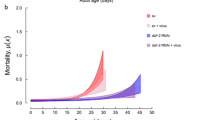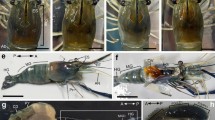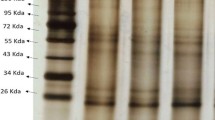Abstract
Insect-parasitic nematodes of the genus Heterorhabditis live in a symbiotic relationship with a gram negative Gamma-proteobacteria of the genus Photorhabdus. This nematode-bacteria pair is a simple and genetically tractable model to study animal-microbe symbiosis. Here we investigated the role of Heterorhabditis nematode C-type lectin (clec) genes in context of nematode-bacteria symbiosis. The in silico analysis identified seven clec genes in H. bacteriophora and three clec genes in H. indica. Two of the clec genes, H. bacteriophora clec-1 (Hb-clec-1) and H. bacteriophora clec-78 (Hb-clec-78) were further characterized. Both of these genes were present in a single copy in the H. bacteriophora genome. The phylogenetic analysis revealed that H. bacteriophora CLEC proteins were close to CLEC-1 and CLEC-78 proteins of free living Caenorhabditis but not to the CLEC proteins of insect-parasitic Steinernema nematodes which share a similar symbiotic relationship with Xenorhabdus bacteria. In situ hybridization showed that expression of Hb-clec-1 and Hb-clec-78 was localized to the alimentary canal of infective juveniles (IJs) in the region of terminal bulb, oesophago-intestinal valve and anterior part of intestine. Hb-clec-78 gene expression displayed significant positive correlation to the presence of bacteria during various stages of symbiosis: it was up-regulated during all the nematode developmental stages when Photorhabdus was symbiotically associated, but down-regulated at the post-IJ recovery stage when the developing nematodes were free of bacteria. Hb-clec-1 gene expression did not show any correlation with presence or absence of symbiont bacteria. Subject to genetic validation, our study suggests that Hb-clec-78 might be actively involved in modulation of symbiosis with Photorhabdus symbionts.




Similar content being viewed by others
References
Bai X, Adams BJ, Ciche TA, Clifton S, Gaugler R, Kim KS, Spieth J, Sternberg PW, Wilson RK, Grewal PS (2013) A lover and a fighter: the genome sequence of an entomopathogenic nematode Heterorhabditis bacteriophora. PLoS One 8:69618. https://doi.org/10.1371/journal.pone.0069618
Bulgheresi S, Schabussova I, Chen T, Mullin NP, Maizels RM, Ott JA (2006) A new C-type lectin similar to the human immunoreceptor DC-SIGN mediates symbiont acquisition by a marine nematode. Appl Environ Microbiol 72:2950–2956. https://doi.org/10.1128/AEM.72.4.2950-2956.2006
Chu DS, Liu H, Nix P, Wu TF, Ralston EJ, Yates JR, Meyer BJ (2006) Sperm chromatin proteomics identifies evolutionarily conserved fertility factors. Nature 443:101–105. https://doi.org/10.1038/nature05050
Ciche T (2007) The biology and genome of Heterorhabditis bacteriophora. WormBook : the online review of C. elegans biology 1–9
Ciche TA, Kim KS, Kaufmann-Daszczuk B, Nguyen KC, Hall DH (2008) Cell invasion and matricide during Photorhabdus luminescens transmission by Heterorhabditis bacteriophora nematodes. Appl Environ Microbiol 74:2275–2287. https://doi.org/10.1128/AEM.02646-07
Clarke DJ (2014) The genetic basis of the symbiosis between Photorhabdus and its invertebrate hosts. Adv Appl Microbiol 88:1–29. https://doi.org/10.1016/B978-0-12-800260-5.00001-2
Cummings RD, McEver RP (2009) C-type lectins. In: Varki A, Cummings RD, Esko JD et al (eds) Essentials of glycobiology. Cold Spring Harbor Laboratory Press, New York, pp 439–457
De Ley P, Blaxter M (2002) Systematic position and phylogeny. In: Lee DL (ed) The biology of nematodes. CRC Press, Boca Raton, pp 1–30
Gaugler R (2002) Entomopathogenic nematology. CABI, UK
Gebremikael MT, Steel H, Buchan D, Bert W, De Neve S (2016) Nematodes enhance plant growth and nutrient uptake under C and N-rich conditions. Sci Rep 6:32862. https://doi.org/10.1038/srep32862
Goldstein IJ, Hayes CE (1978) The lectins: carbohydrate-binding proteins of plants and animals. Adv Carbohydr Chem Biochem 35:127–340. https://doi.org/10.1038/srep32862
Hynes RO, Zhao Q (2000) The evolution of cell adhesion. J Cell Biol 150:F89–F96. https://doi.org/10.1083/jcb.150.2.F89
Kamada N, Seo SU, Chen GY, Nunez G (2013) Role of the gut microbiota in immunity and inflammatory disease. Nat Rev Immunol 13:321–335. https://doi.org/10.1038/nri3430
Kim B, Suo B, Emmons SW (2016) Gene function prediction based on developmental transcriptomes of the two sexes in C.elegans. Cell Rep 17:917–928. https://doi.org/10.1016/j.celrep.2016.09.051
Kimber MJ, Fleming CC, Prior A, Jones JT, Halton DW, Maule AG (2002) Localisation of Globodera pallida FMRFamide-related peptide encoding genes using in situ hybridisation. Int J Parasitol 32:1095–1105. https://doi.org/10.1016/S0020-7519(02)00084-X
Kostic AD, Howitt MR, Garrett WS (2013) Exploring host-microbiota interactions in animal models and humans. Genes Dev 27:701–718. https://doi.org/10.1101/gad.212522.112
Kumar P, Ganguly S, Somvanshi VS (2015) Identification of virulent entomopathogenic nematode isolates from a countrywide survey in India. Int J Pest Manage 61:135–143. https://doi.org/10.1080/09670874.2015.1023869
Kumar S, Stecher G, Tamura K (2016) MEGA7: molecular evolutionary genetics analysis version 7.0 for bigger datasets. Mol Biol Evol 33:1870–1874. https://doi.org/10.1093/molbev/msw054
Lambshead PJD, Boucher G (2003) Marine nematode deep sea biodiversity–hyperdiverse or hype? J Biogeogr 30:475–485. https://doi.org/10.1046/j.1365-2699.2003.00843.x
Le SQ, Gascuel O (2008) An improved general amino acid replacement matrix. Mol Biol Evol 25:1307–1320. https://doi.org/10.1093/molbev/msn067
Lettre G, Kritikou EA, Jaeggi M, Calixto A, Fraser AG, Kamath RS, Ahringer J, Hengartner MO (2004) Genome-wide RNAi identifies p53-dependent and -independent regulators of germ cell apoptosis in C. elegans. Cell Death Differ 11:1198–1203. https://doi.org/10.1038/sj.cdd.4401488
Lewis EE, Glazer I, Gaugler R (1996) Location and behavioral effects of lectin binding on entomopathogenic nematodes with different foraging strategies. J Chem Ecol 22:455–466. https://doi.org/10.1007/BF02033648
Livak KJ, Schmittgen TD (2001) Analysis of relative gene expression data using real-time quantitative PCR and the 2− ΔΔCT method. Methods 25:402–408. https://doi.org/10.1006/meth.2001.1262
Loukas A, Mullin NP, Tetteh KK, Moens L, Maizels RM (1999) A novel C-type lectin secreted by a tissue-dwelling parasitic nematode. Curr Biol 9:825–828. https://doi.org/10.1016/S0960-9822(99)80366-2
Mallo GV, Kurz CL, Couillault C, Pujol N, Granjeaud S, Kohara Y, Ewbank JJ (2002) Inducible antibacterial defense system in C. elegans. Curr Biol 12:1209–1214. https://doi.org/10.1016/S0960-9822(02)00928-4
O’Rourke D, Baban D, Demidova M, Mott R, Hodgkin J (2006) Genomic clusters, putative pathogen recognition molecules, and antimicrobial genes are induced by infection of C. elegans with M. nematophilum. Genome Res 16:1005–1016. https://doi.org/10.1101/gr.50823006
Pauli F, Liu YI, Kim YA, Chen P, Kim SK (2006) Chromosomal clustering and GATA transcriptional regulation of intestine-expressed genes in C. elegans. Development 133:287–295. https://doi.org/10.1242/dev.02185
Poinar GO (1975) Description and biology of a new insect parasitic rhabditoid, Heterorhabditis bacteriophora n. gen., n. sp.(Rhabditida; Heterorhabditidae n. fam.). Nematologica 21:463–470. https://doi.org/10.1163/187529275X00239
Ruby EG (2008) Symbiotic conversations are revealed under genetic interrogation. Nat Rev Microbiol 6:752–762. https://doi.org/10.1038/nrmicro1958
Schulenburg H, Hoeppner MP, Weiner J, Bornberg-Bauer E (2008) Specificity of the innate immune system and diversity of C-type lectin domain (CTLD) proteins in the nematode Caenorhabditis elegans. Immunobiol 213:237–250. https://doi.org/10.1016/j.imbio.2007.12.004
Schwarz R, Dayhoff M (1979) Matrices for detecting distant relationships. In: M. Dayhoff (ed) Atlas of protein sequences, National Biomedical Research Foundation, p 353–358
Shapira M, Hamlin BJ, Rong J, Chen K, Ronen M, Tan M (2006) A conserved role for a GATA transcription factor in regulating epithelial innate immune responses. Proc Natl Acad Sci U S A 103:14086–14091. https://doi.org/10.1073/pnas.0603424103
Smith CJ, Watson JD, Spencer WC, O'Brien TD, Cha BJ, Albeg A, Treinin M, Miller DM (2010) Time-lapse imaging and cell-specific expression profiling reveal dynamic branching and molecular determinants of a multi-dendritic nociceptor in C. elegans. Dev Biol 345:18–33. https://doi.org/10.1016/j.ydbio.2010.05.502
Somvanshi VS, Kaufmann-Daszczuk B, Kim KS, Mallon S, Ciche TA (2010) Photorhabdus phase variants express a novel fimbrial locus, mad, essential for symbiosis. Mol Microbiol 77:1021–1038. https://doi.org/10.1111/j.1365-2958.2010.07270.x
Somvanshi VS, Sloup RE, Crawford JM, Martin AR, Heidt AJ, Kim KS, Clardy J, Ciche TA (2012) A single promoter inversion switches Photorhabdus between pathogenic and mutualistic states. Science 337:88–93. https://doi.org/10.1126/science.1216641
Somvanshi VS, Gahoi S, Banakar P, Thakur PK, Kumar M, Sajnani M, Pandey P, Rao U (2016) A transcriptomic insight into the infective juvenile stage of the insect parasitic nematode, Heterorhabditis indica. BMC Genomics 17:166. https://doi.org/10.1186/s12864-016-2510-z
Spencer WC, Zeller G, Watson JD, Henz SR, Watkins KL, McWhirter RD, Petersen SC, Sreedharan VT, Widmer C, Jo J, Reinke VJ, Petrella LN, Strome S, Von Stetina SE, Katz M, Shaham S, Ratsch G, Miller DM (2011) A spatial and temporal map of C. elegans gene expression. Genome Res 21:325–341. https://doi.org/10.1101/gr.114595.110
Waterfield NR, Ciche T, Clarke D (2009) Photorhabdus and a host of hosts. Annu Rev Microbiol 63:557–574. https://doi.org/10.1146/annurev.micro.091208.073507
Acknowledgements
M.Sc. student CGB acknowledges the Junior Research Fellowship from the Indian Council of Agricultural Research, and PG School, ICAR-Indian Agricultural Research Institute, New Delhi. This work was supported by funding from Science and Engineering Research Board, Department of Science and Technology, Government of India [Grant no. SB/SO/AS/010/2014 to VSS], and in-house funding from the Division of Nematology, ICAR-Indian Agricultural Research Institute, New Delhi.
Author information
Authors and Affiliations
Corresponding authors
Electronic supplementary material
ESM 1
(DOCX 17 kb)
Rights and permissions
About this article
Cite this article
Bhat, C.G., Chauhan, K., Phani, V. et al. Expression of Heterorhabditis bacteriophora C-type lectins, Hb-clec-1 and Hb-clec-78, in context of symbiosis with Photorhabdus bacteria. Symbiosis 77, 49–58 (2019). https://doi.org/10.1007/s13199-018-0569-9
Received:
Accepted:
Published:
Issue Date:
DOI: https://doi.org/10.1007/s13199-018-0569-9




